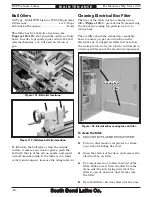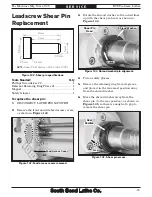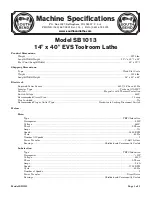
-72-
For Machines Mfg. Since 7/09
EVS Toolroom Lathes
S E R V I C E
Instead, take the time to carefully line
up the two bores. You may file a slight
chamfer on the end of the pin to make it
easier to insert.
10.
With the pin completely seated in the bore
and the head flush with the leadscrew
shoulder, slide the shroud washer against
the shoulder, then rotate the washer 180°
until it covers the head of the shear pin, as
shown in
Figure 148
.
Figure 147. New shear pin installed in bore.
New Pin
8.
Insert a blow gun tip into the shear pin hole,
blow out the hole with compressed air, and
put a drop of oil in the hole.
9.
Insert the new shear pin into the bore, as
shown in
Figure 147
.
7.
Use the magnet to remove the shear pin
head, then rotate the lathe spindle to line
up the inner and outer bores, as shown in
Figure 146
. Next, use the magnet to remove
the other half of the broken shear pin when
it becomes visible.
11.
Using retaining ring pliers, return the
retaining ring to its groove, and position
the retaining ring ears over the shear pin
head, as shown in
Figure 149
, to prevent
the shear pin from falling out—if the shroud
washer rotates into alignment with the pin
access groove lines.
Figure 149. Retaining ring positioned with ears in
front of pin access groove, so pin cannot fall out.
12.
Re-install the access covers.
Figure 148. Shroud washer positioning.
Rotate
Washer
Slot 180°
Figure 146. Aligned shear pin bores.
Outer Bore
Inner Bore
— If the pin does not freely slide into the
bore, DO NOT hammer on the pin or
you may permanently damage the shear
mechanism and bore, making it nearly
impossible to remove and install a new
shear pin later.
Summary of Contents for SB1013F
Page 120: ......




































